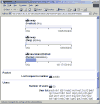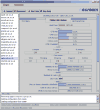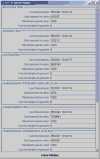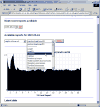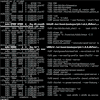CMS Screen Shots
i-scream screenshots
This page provides a sequence of screenshots to help you to gain a better understanding of the i-scream distributed central monitoring system and how it may be applied in networked environments. Click on the thumbnails to view the full size screenshots.
Reports Centre (Web)
The i-scream reports centre provides a central access point
to all web-based reports that are provided by the i-scream
system. Reports are available to display information
about the current status of an individual machine and any
alerts pertaining to either an individual machine, or a
summary of alerts for all machines. Historical
information about monitored machines may also be accessed
from this point.
Latest Information (Web)
Here we are viewing the latest information provided by a
host. Bars are used to represent values such as disk
space and free memory as this makes it easier to spot casual
problems. The small graph icons link to historical
reports of each field for the previous day. The choice
of fields to display on this page is stored in a separate
configuration file.
Conient (Multiplatform real-time client)
Conient is a real-time client
that can hook into an i-scream server to allow the user to
view host information as it passes through the server.
The client displays information provided by the hosts as well
as the results of service checks performed by the server on
each host (eg FTP, Telnet, etc). Conient is written in
Java and can thus be run on most operating systems.
Conient (Viewing extra data)
Less important host information may be viewed in a seperate
window to avoid clutter in Conient's display. Details
of the protocol for host-to-server communications are freely
available to developers. The protocol itself is
extensible and client programs such as Conient display even
unrecognised data from modified host programs.
Conient (Configuration)
Conient is fully configurable from within the program
itself. Multiple configurations may be saved.
Conient can also be configured to connect to a server through
a firewall via an SSH tunnel or suchlike.
ihost (Unix/Linux host)
The ihost is currently the main Unix/Linux/FreeBSD host
application for i-scream. ihost is centrally configured
by the server it connects to and periodically sends
information about the machine on which it is running.
The ihost is written in Perl, so can be easily altered to
send extra information to your i-scream server.
WinHost (Windows host)
The WinHost is similar in concept to the ihost, however, this
one runs on Windows NT/2000 servers. Again, the
configuration is dynamically obtained from the server.
The WinHost is typically only present in the Windows system
tray. Double clicking on the system tray icon will
bring up a small window that allows data to be viewed and to
force reconfiguration with the server.
Alerts (Email)
The i-scream server includes many alerting mechanisms.
Simple email alerts may be sent out if desired. Alert
levels and frequencies may be configured for the
server. This screenshot shows the format of a typical
alert; the contents of which are of course configurable.
Alerts (IRC bot)
Another i-scream alerter comes in the form of an interactive
IRC bot. This may reside in an IRC (Internet relay
chat) channel and broadcasts alerts if told to do so.
This screenshot shows a typical interaction with a user in
the "Bersirc" IRC client.
Alerts (Web page)
Individual alerts and a summary of all alerts raised by the
i-scream server may be viewed on the alerts web pages.
These show the different levels of alerts in configurable
colours and provides specific details about the alerts being
raised for each machine.
Alerts (Public helpdesk display)
The reports centre also
provides a page that may be useful in configuring
non-interactive public displays of alerts. These
displays automatically refresh the page periodically and
supported web browsers may also automatically scroll the page
to allow a large font to be employed for easier reading from
a distance.
Conient (Server queue monitoring)
The Conient client may also be used to
monitor information about the i-scream server itself.
Here we are viewing the status of the internal queues within
the server. This shows that the server is performing
healthily and that there are no bottlenecks.
Historical reports (Web)
Historical information is collated by the
i-scream server into (typically) a MySQL database. A
separate program is used to produce the historical web
reports These may be browsed via this web-based interface
(see screenshot). The reports to be generated for each
machine and the size of the page are of course configurable.
Historical reports (Metadata)
The historical report generation also
produces a number of other files that may be useful for third
party analysis tools. The chart itself is written as a
GIF image, as well as a small file suitable for including on
PHP pages that specifies the minimum and maximum values
during the 24 hour period. A file containing the raw
plot data is also produced to enable the use of third party
on-the-fly plotting tools.
The i-scream server
The server is distributed and may therefore have multiple
points of data entry and run on more than one machine.
This helps to reduce the amount of host traffic over large
networks and reduces potential bottlenecks. The server
is written in Java to allow it to run on most operating
systems. This exciting screenshot shows the i-scream
server running ;-)

